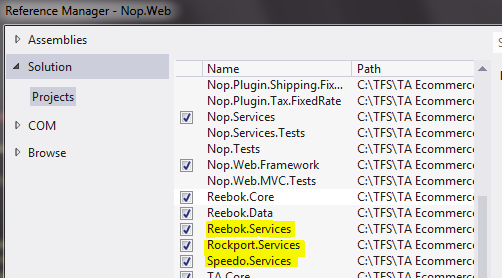Scope
As previously suggested,
At the end of this session, we want to achieve,
It is not so easy to deploy, as I need to build the project once per brand (so it will generate different dlls)This technique rely on the developers to build a different BrandedService.dll that the IoC will pick up via IDependencyRegistrar. This gives different brands a slightly different set of dlls as it was hard to maintain.
At the end of this session, we want to achieve,
- Only build once and use the same set of dlls across all brands.
- Easy for the developers to deploy.
Code
- We store a unique id "BrandId" in our Web.config, and of course we will utilize web config transformation for this matter.
- In the DependencyRegistrar for each brand project, we only register the classes if the brand id matches.
- IoC will register different concrete classes during reflection (as usual).
- Brands without matching ids simply will have the register logic skipped (although the IoC will still run the through the class because they all implement the IDependencyRegister.
As demonstrated in code, this is the DependencyRegister for TNF.Services and Speedo.Services.
A snapshot of the bin folder shows the dlls are exactly the same for different tenants.
There will be a redundant TNF dlls in Speedo project and vice versa, but my time is more valuable than a few kb dll, so I think this is a better approach. Removal of redundant dlls will not break the site :)
Nop.Web
In our web project, we need to voluntarily register all our Brand.Services dll, this will force MSBuild to include all the dlls during build or publish.
Conclusion
Both of these approach have their pros and cons. I am sure there will be other ways doing this too. The key is the developers or the team must be comfortable with the process, and the people doing it are happy about it.
Further Improvement
nopCommerce uses App_Data\Settings.txt to store database connection string. This works fine for staging or live site as we just need to skip App_Data during deployment. However, it became a hassle to swap connection string for local development as web config transformation does not help in this situation. More into this topic next time.




No comments:
Post a Comment